- Popular Types of Bermuda Grass Explained - April 21, 2022
- When to Mow New Grass - April 18, 2022
- Best Troy Bilt Push Mower: How to Find The Right One - April 25, 2021
Your Lawns require the best grass seed if you want to improve their overall outdoor outlook. A thriving lawn attracts individuals and families to nurture and make it evergreen to meet intended purposes.
One can either plant warm or cool-season seed grass, depending upon the prevailing seasons. If you live in Connecticut, it can help use some grass seed options in this write-up.
Factors to consider before buying the Best Grass Seed for CT

What could be the correct type of grass seed? Of course, it should align with your climate, the property’s unique geography, and your intended use.
Landing perfect grass seed for your lawn promotes your efforts in improving the entire landscape. Let us observe the following points before implementing any purchase decisions.
Levels of shade
Different grass seeds require varying levels of shade to flourish. For example, Bermuda grass can excel well in nothing less than full sun exposure.
Other seed types like Tall Fescues require partial shade to develop optimally. Ensure that you understand season patterns and weather behaviors to form reasonable decisions that will compliment your choices.
Seed Quantity
One critical factor that affects the health of our lawn is the amount of seed to use. If you are running on a budget on bigger sites, then settling for turfgrass will not harm you. It sounds helpful to determine the amount of seed to avoid under-seeding your lawn to prevent additional costs.
One seed type requires over-seeding to develop a lush, dense, and thick turf. When you overseed, you will be containing weeds and allow the new breed to dominate and restore uniformity.
For example, some grass seeds require a seed rate of 3 pounds per meter to deliver better results, while some brands may consume less.
Cool-season vs warm-season grass seed
Warm-season grass thrives in hot and warm weather. With the onset of cooler temperatures, it turns brown and goes brown naturally.
Too much shade is not beneficial to this option because it flourishes well in sunlight. One should plant warm season grass during late spring so that they gain momentum in the hot summer. Such varieties include Bermuda and Zoysia grass seed.
The cool season option grows in the spring and the fall rapidly. Unlike warm-season counterparts, such alternatives turn brownish and patchy during hot summers. You must observe correct timing when planting as they respond well when in early fall. Some notable examples include Tall Fescue and Kentucky.
Wear and Tear
Establish the purpose before purchasing any grass seed because it can be discouraging if these plants do not complement your goals.
For instance, if you are growing in high-traffic areas like golf courses, ensure that your options can withstand heavy use without damage. High tolerance in soccer fields preserves the health of your lawn.
Similarly, you can improve traffic tolerance by blending with an alternative with stronger properties. Creeping grass can fill holes naturally, leaving no spots with time. Spots occur when the grass begins to brown during certain conditions.
Soil condition
Different grass seeds can survive in varying soil conditions. If your land is sandy or loamy, ensure that you plant the right seed that agrees with your current soil type. Some seed grass can still thrive in saline soils and produce desirable results.
On the other hand, understand the right soil PH that supports specific grass seed types to overcome related challenges. Another important aspect is to know the kind of nutrients to feed your grass. Some seeds prefer more nitrogen content than others.
Terrain
The fact that you have a sloping landscape does not imply that you avoid planting grass seed in such sites. One concern on a slope is potential erosion and rain that can wash away your seeds. You can make use of erosion control blankets to keep your soil packed and prevent further damage.
Review of the Best Grass Seed for CT
Owning a home comes with heavy responsibilities, such are caring for your lawn, which can be time-consuming. You will have to worry about planting new grass seeds, mowing and fertilizing these plants.
We will be introducing you to both warm and cool seasoned grass seed to support your landscaping needs. Here are suitable options for you.
Zoysia Grass
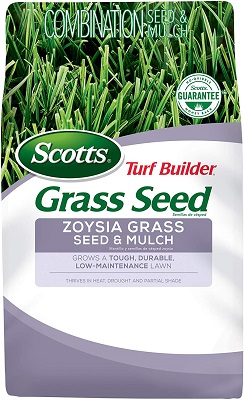
Zoysia is a warm-seasoned grass with the ability to stand the heat, although it has improved cold-tolerance elements. Such grass prefers sun and can still tolerate some light shade to deliver a beautiful and dense lawn with little input from you.
Zoysia can establish slowly and later form a thick carpet grass under your feet. This grass spreads above-ground stems (stolons) to create beautiful lawns for entertainment and games.
Zoysia remains light to medium green during active growth but turns brown when winter dormancy sets in. One inch of rainfall or weekly irrigation is enough to maintain its lawn. You can mow this slow-growing grass to retain a height of one to one and a half inches.
However, this grass type prefers a soil PH that ranges between 5.8 and 7.0. You can retain the PH by applying lime and optimizing nutrient availability.
Being a drought-resistant grass, it also requires low maintenance costs. If you live in southern or transitional zones, then this type of grass is for you. It is a versatile grass with low water requirements while tolerating high traffic. You should perform dethatching and aeration in early springs to allow the grass to recover over peak growth.
Pros
- Being warm seasoned grass, it has properties for cold tolerance
- Low water consumption with low maintenance requirements
- It has a deep root system to retain moisture and resist drought
- Forms thick and dense lawns that are traffic tolerant
- Suitable for developing lawns to serve as sports grounds
Cons
- Can damage if you subject it to high traffic consistently
Kentucky Bluegrass (KBG)
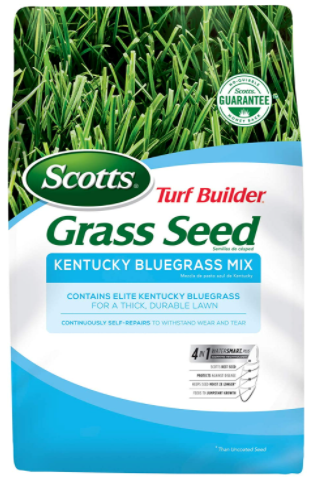
Kentucky bluegrass is famous for its versatility since it first came to the US as a pasture grass from Europe and Asia. Afterward, many users began to grow it as premier lawn grass throughout the country.
Kentucky is a perennial cool-seasoned grass meaning it grows in the cool seasons vigorously. Different Kentucky grass varieties have relatively shallow roots, making them have a low tolerance to drought and heat.
Kentucky bluegrass establishes from seeds and germinates slowly than other cool-seasoned counterparts. This sod-forming grass is self-spreading through underground stems (rhizomes) to form a thick and dense turf. Such aggressive growth habits give it the capacity to recuperate from damage quickly. A healthy KBG lawn will display rich emerald to blue-green color.
One can maintain a KBG lawn by performing deep intensive irrigation to support deep root growth, unlike shallow watering.
During normal weather, you can use 1 inch of rainfall to maintain a typical KBG lawn. Two or more inches are enough per week during warmer weather. You can mow this grass to 2 and 2.5 inches high; however, you can maintain 3 to 4 inches during high heat and lower rainfall periods.
Pros
- Excellent winter hardiness to keep your lawn attractive and beautiful
- Self-spreading to form thick and dense turf killing other field weeds quickly
- Has a great capacity to recover from any potential damage within no time
- Fast greening to develop lush, versatile cool-season lawns
- Combines with other varieties to promote high drought tolerance
Cons
- Vulnerable to stress damage
Tall Fescue Grass
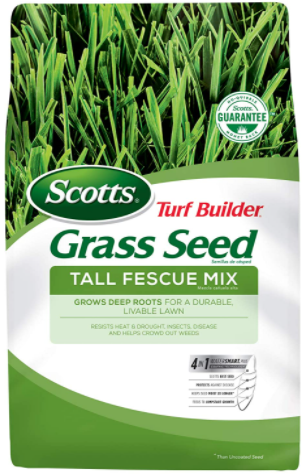
Another perennial cool-weather grass with an aggressive growth habit is Tall Fescue. It has wide blade leaves and dark green color.
Furthermore, this grass seed has small rhizomes spreading by seed distribution rather than creeping. It is a tough grass being a good choice for play areas, but you can perform reseeding where you see bare spots. Such a variety can mature when it attains a height of 4 to 12 inches.
The right time to grow this cool-seasoned grass is in the fall and spring. Tall Fescue grass’s unique property tends to a bunch, requiring periodic overseeding to maintain density and prevent clumpy appearance.
This grass develops a deep root system extending to two to three feet to retain moisture and promote drought resistance properties. As such, it can survive without regular watering.
Tall fescue can grow in full sun with great shade tolerant properties. The good news is this grass is adaptable to different types of soil. With a deep root system, it can draw nutrients from the moisture of varying soil types. You can use 3 pounds of nitrogen-based fertilizer for every 1000 square feet of lawns.
You can blend it with other cool seasoned grass like Kentucky bluegrass to strengthen the lawn for high traffic tolerance.
Pros
- Has deep root system to tap underground moisture and remain drought resistant
- Adaptable to different types of soil by forming a dense, green, and healthy lawn
- Blends with other grass types to increase the strength of traffic tolerance
- Requires little fertilization, thereby promoting low maintenance costs
- Leaves can absorb little moisture to promote minimal slippage
Cons
- Susceptible to fungal diseases such a brown batch
Perennial Ryegrass
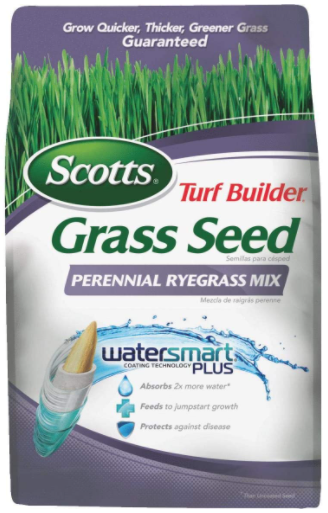
Perennial Ryegrass has a fast germination rate to encourage quick establishment and become a valuable component in temporary and permanent lawns.
If you subject it to proper growing conditions, it forms a lush fine-bladed lawn that maintains color in winter. This cool-season grass grows well during a cool environment from the fall through spring. It also flourished where summers are moderate.
Like Tall fescue, Perennial Ryegrass is a bunch that grows into clumps and can spread through vertical shoots. Typical varieties have a shallow root system, which limits their tolerance to heat and drought.
Another good feature is this perennial Ryegrass prefers sun and can still tolerate lightly shaded conditions. Ensure you plant this grass during the right season in cool temperatures to compliment a natural growth.
When mowing, you should maintain a height of 1.5 to 2.5 inches. It is noteworthy that this type of grass has high fertilizer and moisture needs.
You can perform frequent irrigation to retain color during low rainfall and heat periods. During short periods of drought, this grass can go dormant but will later recover quickly. In case of a prolonged drought, why not overseed your lawn.
Pros
- Has fast germination and seedling growth to form a dense lawn
- Can withstand light shade and flourishes well during cool seasons
- Suitable for creating both permanent and temporary lawns
- Mixes with other cool-season grass to produce a strong and reliable lawn
- Such a variety is tough and durable
Cons
- Requires high water and fertilizer to keep it healthy
Penncross Creeping Bent Grass
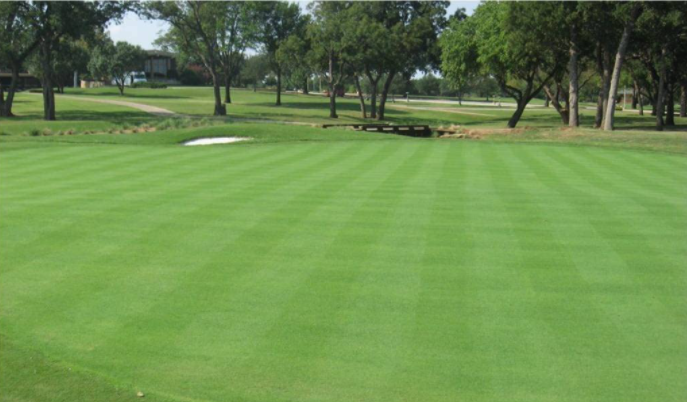
Penncross Creeping Bentgrass can perform under different conditions hence adaptable to other regions of the world. It is aggressive with high wear tolerance and suitable for tees, fairways, and golf courses.
For instance, it can survive in both extreme cold and heat and still retain its typical characteristics. Perform a soil test before planting because the right PH should range between 5.5 and 8.
The optimum mowing height is 3/16 to 5/16 inch, but one can adjust it to lower or higher depending upon the intended use and maintenance practices.
This grass can perform better in sandy soils but can still tolerate clay soils with enough drainage. Although its varieties can show dismal performance in wet areas, this option can withstand saturated soil conditions for a short period.
Growing such grass is always rewarding when you want to put your home green. Growing involves using one to two pounds of seeds for every 1000 square feet. Depending on the spoils temperatures, germination takes place within 7 to 15 days. You can perform the first mowing after thirty days when this plant has a proper root system.
Pros
- Great wear tolerance, therefore ideal for high traffic areas like golf course and fairways
- Withstands different weather conditions hence adaptable in different places of the world
- Promotes garden and lawn beauty by consistent greening
- It needs moderate nitrogen; therefore cost-effective
- It is rewarding to grow and maintain
Cons
- It might not be the best alternative in wet areas
Bermuda grass
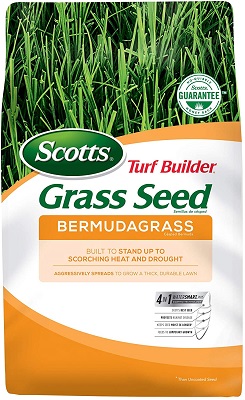
When talking of a high capacity to withstand heavy use, Bermuda grass takes the lead. It has awesome heat and drought tolerance and can later recuperate quickly to form a green and healthy lawn.
Bermuda grass is native to subtropical and tropical countries, making it a perennial warm-season plant. Lack of cold tolerance makes it a leading choice in southern states and Connecticut.
Bermuda grass flourishes in places with good drainage and direct sunlight. It has a unique characteristic which it enjoys, such as superior humidity, salt, and heat tolerance.
That owes to a deep and resilient root system stretching to 6 feet to protect it against some environmental stresses. This plant has an aggressive growth rate and recovers after heavy use, therefore suitable for the golf course and athletic fields.
Due to a fast growth rate, Bermuda grass needs more maintenance than other options. During peak season, you must perform monthly fertilization.
Also, you can mow it twice a week during such a period. Although this plant is drought tolerant, it can go dormant when the drought extends for long. The right soil PH for planting is 5.8 to 7.0 with an optimal level of nutrients availability.
Pros
- Fast-growing grass to withstand high traffic and recovers evenly after damage
- An extensive root system allows it to have more resilience to specific environmental stresses
- One can blend it with other options to make it cold tolerant with self-repairing properties
- Over-seeding makes it develop a healthy, lush, and attractive lawn
- Survives well in areas of high heat, drought, and saline conditions efficiently
Cons
- Increased nutrients and maintenance requirements
Carpetgrass
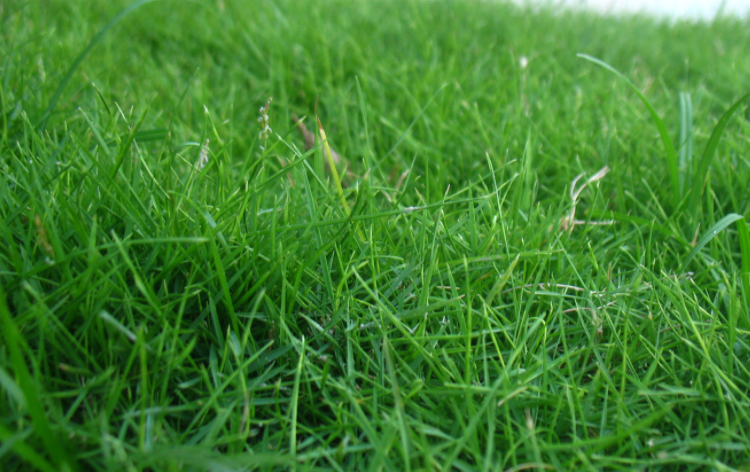
Carpetgrass is a warm-season plant that spreads by creeping stolons to crease a dense lawn. Native to the Gulf States, it can be useful as a tough grass since it thrives in remote areas where different grasses fail to flourish.
When temperatures go down, it can easily turn to brown cool, and it will be the last to green up in spring. However, it can grow to a comfortable height of half a meter.
Carpetgrass bears unattractive seed heads to make your lawn have a weedy appearance. One can prevent seed heads by mowing the lawn after every five days to retain a height of one to two inches.
If allowed to grow for a prolonged period, such seed stalks can be tough and hard to mow down. Despite such downsides, carpetgrass can excel in shady or boggy areas.
You can plant this grass in the fall of spring frost. Before planting, perform good land preparation by loosening the soil particles to become smooth. Sow the seeds at a normal rate of 2 pounds for every 1000 square feet.
Rake lightly after sowing the seed to cover them well. For better results, ensure to keep the soil moist for at least two weeks and perform a consistent watering for the next eight weeks.
Pros
- Spreads by creeping evenly to produce high-quality lawns
- It is a multipurpose grass the consumer to apply it widely
- Requires low nitrogen nutrients than other plants for it to establish
- Exceptional drought resistance features to retain green color during summer
- Extensive usage in parks, roadsides, and cemeteries
Cons
- Mowing twice-weekly increase maintenance costs
Centipede grass
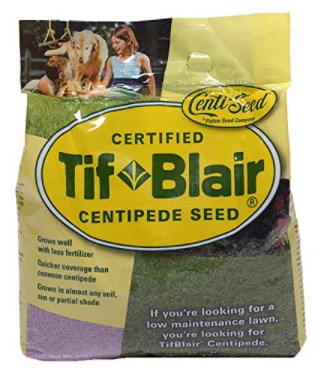
Centipede is a warm-season that accessed American soil from China. It experiences productive growth during warm weather such as hot summer months and late spring.
It is sensitive to cold temperature, but it can withstand all periods of winter when grown in mild climates. The rate of growth depends upon soil and climate requirements. For example, it can flourish in acidic and sandy soils.
Although it excels in sandy soils, it requires a PH of between 4.5 and 6.0. Also, it is sensitive to iron deficiencies, which is responsible for leaf yellowing. Lack of winter dormancy causes it to be vulnerable to winter cold. As the temperature drops, centipede grass can sustain damage. In the same vein, repeated injuries during winter can prove to be fatal.
The recommended height of mowing centipede grass is 1.5 to 2 inches. Once established, you can use little fertilizer to keep it healthy since over-fertilization leads to lawn disease. Ensure you water deeply and thoroughly to encourage deeper roots because shallow roots are susceptible to stress.
Pros
- Requires low maintenance practices such as little fertilizer application
- A relatively extensive root system makes it remain green during hot summer.
- Heat tolerant grass to survive in harsh weather conditions without waning in quality
- Enhances dense and attractive turf to improve your lawn’s image
- One and mix it with other varieties to form an evergreen lawn in all seasons
Cons
- Deteriorates when exposed to heavy traffic and recovers slowly
FAQs
Answer: The suitable time to plant grass seed in CT is around mid-August and mid-September yearly. Within such a period, such seed can germinate and flourish rapidly. Alternatively, you can settle for early spring or late winter.
Answer: You only need to have good land preparation for your grass seed to sprout. One will not purchase new topsoil or any form of special soil for the seeds to germinate properly.
Answer: The two items do not require a specific formula as you apply them. You can spread them simultaneously or apply them as separate entities.
Wrapping Up
Connecticut State has the right climate and weather conditions to support both warm and cool-season seed grass. It is upon your to know which kind of grass seed to apply depending on these two factors.
Above all, our list has awesome products to meet your lawn requirements. However, our favorite is Zoysia grass seed, which tolerates both warm and cool conditions.
It is self-spreading to create thick and dense lawns within a short period. A deep root system allows it to draw more moisture and resist heat and drought during summer. Also, it requires low water consumption with low maintenance needs.

